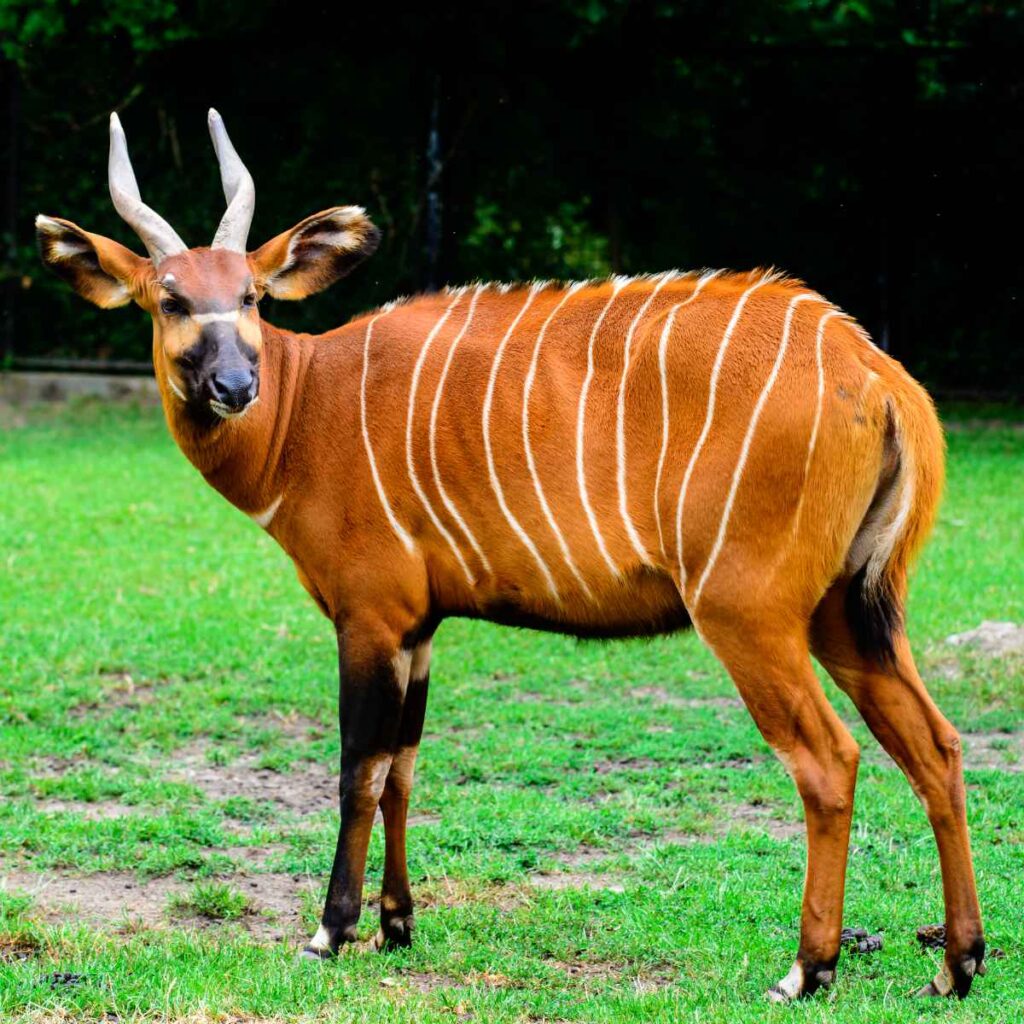Last Reviewed and Updated on January 25, 2023
Bongo antelopes are a magnificent species with striking red coats, white stripes, and impressive horns. Let’s explore some interesting facts about bongos, from the basic information about this wonderful antelope species to why they eat charred wood.

About Bongo Antelopes
Bongos (Tragelaphus eurycerus) are large, forest-dwelling mammals that belong to the family Bovidae. They are native to central and western Africa’s forests and mountain forests.
There are two subspecies of bongos;
- The western or lowland bongo
- The eastern or mountain bongo
These heavily built animals have a reddish-brown or chestnut coat that is covered in vertical white stripes, and they have distinctive white markings on their face and ears. Both males and females have long, spiral horns, with males’ horns being more prominent than that of a female.
Males and females are similar in size. They have a body height of about 3.6 to 4.3 ft / 1.1 to 1.3 meters at the shoulders and a body length of about 7.1 to 10.3 ft / 2.15 to 3. 15 (including the tail).
Females are lighter than males, with females weighing about 331–518 lb / 150–235 kg and males about 485–893 lb / 220–405 kg.
Their diet consists mainly of foliage, fruits, and plants; they also consume grass and shrubs.
Facts About Bongo Antelopes
We’ve covered the basics; now, let’s explore some facts about bongo antelopes that make this species unique.

1. Bongos are one of the largest antelopes in the world
They are the world’s largest forest antelope by size and weight. They are also one of the largest species of all antelopes.
2. Coats of males become darker as they age
One of the distinct traits of bongos is their coat color. Their coat is a bright auburn or chestnut color (darker tones on legs, neck, and chest), along with almost white stripes.
As males mature, their coat gradually becomes darker, reaching a dark mahogany-brown coat color.

3. When it comes to other bongos, they rely on visual identification
Unlike other similar antelopes, bongos don’t have special scent-secreting glands; this means they don’t rely on scent to find one another.
Their ears have distinctive patterns, which are thought to help bongos identify one another.
4. Their horns are hollow
Just like other antelopes, the core of their horns is hollow.
Unlike deer, bongos don’t shed their horns; they keep them throughout their lives.
5. Bongos eat burned wood after storms
They require salt in their diet, and one way to get salt and other minerals are to eat burnt wood after a storm. This wood, struck and burned by lightning, is a rich source of salts and minerals. This behavior was also observed in the okapi (not closely related species).
6. Bongos have prehensile tongues
Prehensile limbs, tongues, or tails are capable of grasping objects.
Like giraffes, bongos have prehensile tongues, which help them reach and grab fresh leaves higher up or pull out roots from the ground.
7. Eastern or mountain bongos may have bald patches, which they make themselves
They tile their heads back when running through the forest, and their horns may rub against their back, creating bald patches.
8. Bongos are one of the most colorful antelope species
Their wonderful coat colors and the striped pattern place them right at the top.
9. Moutain bongos are only found in one remote region of Kenya
In the wild, they are only found in a few mountain regions of central Kenya. This subspecies of the bongo is critically endangered. There are fewer individuals in the wild than there are in captivity.
10. The color of their coat may “wash off”
The color pigments in their coats rub off easily, with anecdotal evidence suggesting rainwater pouring down their coat can become red-tinted.
